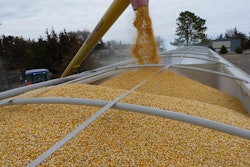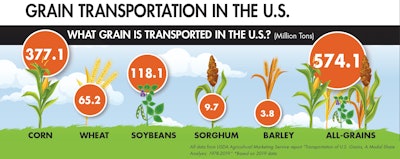
In 2021 the United States produced 15.1 billion bushels of corn, 4.44 billion bushels of soybeans, 1.64 billion bushels of winter, spring, and durum wheat, 373 million bushels of sorghum, and 171 million bushels of barley according to theUnited States Department of Agriculture(USDA)World Agricultural Supply and Demand Estimates(WASDE).
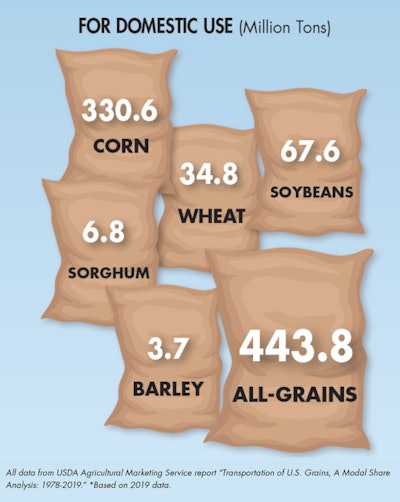
The U.S. produces a staggering amount of grain, and whether it's destined for domestic use or exported, all grain that is produced is moved by truck, rail or barge, most often a combination of the three. The USDAAgricultural Marketing Service(AMS) has continuously updated a report,Transportation of U.S. Grains - A Modal Share Analysis, since 1992. The 12th update was published in October 2021 and provides a breakout of corn, wheat, soybeans, sorghum, and barley transportation methods to either domestic markets or U.S. ports for export between 1978 and 2019. Originally published in theApril/May 2022 issueofFeed & Grain,this infographic distilled some of the report's most interesting findings.
Grain transportation modes compete while working together
The purpose of the Transportation of U.S. Grains - A Modal Share Analysis is to provide information about the long-term trends in the competitiveness and efficiency among grain transportation modes. The health of the U.S. grain transportation system depends on a delicate balance of truck, rail and barge shipments. Competitiveness among the three is important in order to keep grain transportation costs low, but the three also need to cooperate because most grain requires multiple modes of transportation to reach its destination.
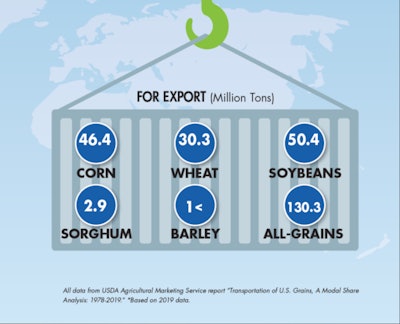
Though exports often get the most attention, almost 450 million tons of grain that move through the grain transportation network will be used domestically. Another 130 million tons will be exported to another country. Almost all of that grain will, at some point, be transported via truck. The analysis estimates that 383 million tons of grain are transported by truck at some point. That number may be higher, there is no organization that tracks grain moved by truck. Other analyses of grain movements have relied on survey data to overcome this, but the authors of the report estimate the number based on known grain production data, as compared to the estimates of the railed and barged volumes of grain.
Barges transport 64.4 million tons and rail transport 126.5 million tons, both numbers are more accurate measurements. have more accurate transportation numbers. The report uses Waterborne Commerce Statistics of the U.S. Army Corps of Engineers to calculate tonnages for barge statistics and the Carload Waybill Sample from the Surface Transportation Board to estimate the amount moved by rail.
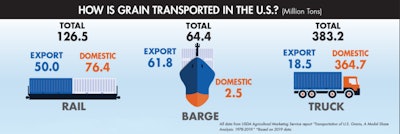
Grain transportation methods are affected by destination and type
Most grain that the U.S. produces is also used here. Around 443.8 million tons are shipped to domestic locations, almost three times the amount that is exported, 130.3 million tons. Much of that domestic use is taken up by the U.S. largest crop, corn. Domestic transportation of corn is 330.6 million tons, while only 46.4 million tons are transported for export.
Unsurprisingly, grain being shipped domestically is primarily transported by truck. Of the 383.3 million tons of grain moved by the truck grain shipping industry, 364.7 million tons of grain to domestic locations and just 18.5 million tons for export.
The least amount of grain shipped by barge, though that makes sense given the need for a waterway large enough to accommodate barges. Barge grain transportation is the opposite of grain shipped by truck. The grain is primarily bound for export, 61.8 million tons. Only 2.5 million tons of grain transported by barge will be used domestically.
Rail is somewhere between truck and barge grain transportation. It moves 126.5 million tons annually, and the destination is a bit more evenly split, 50 million tons are loaded for export, and 76.4 million tons will be used domestically.
Though grain shipment methods vary based on numerous factors, not the least of which is the availability of transportation types, the U.S. grain transportation system is a marvel. With continued development and careful monitoring, it will continue to make U.S. grain production a global powerhouse.
To see this infographic as originally published, clickhere.

.jpg?auto=format%2Ccompress&crop=faces&fit=crop&h=48&q=70&w=48)







